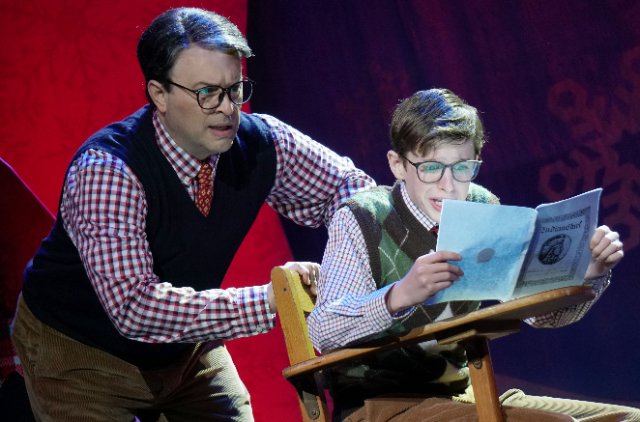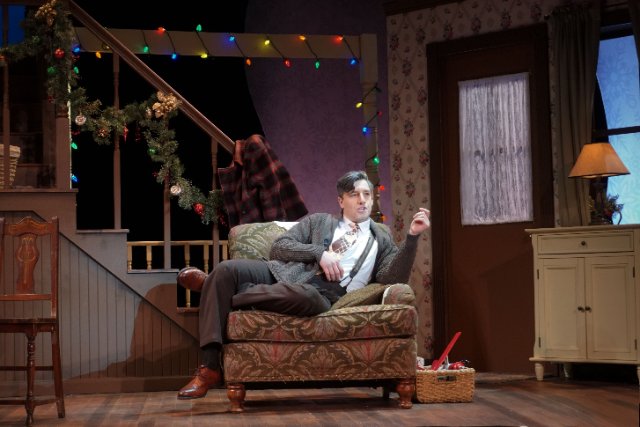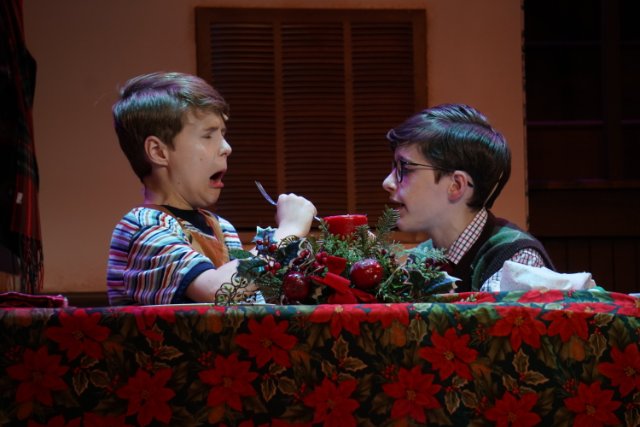A Christmas Story: The Musical
Stage Adaptation Of Beloved Film in South Florida
By: Aaron Krause - Dec 20, 2019
“Who could want much more,” sing Parker family members, of A Christmas Story fame.
Through song, they’re describing how happy and satisfied they feel. They’re experiencing a lovely and thoroughly satisfying Christmas in 1940’s Indiana.
But we could easily ask the aforementioned question about A Christmas Story: The Musical. It is the stage adaptation of the classic 1983 movie about a boy who wants a BB gun for Christmas.
Indeed, who could want much more after witnessing the multi-award-nominated musical? It includes a score by the vastly-talented songwriting team of Benj Pasek and Justin Paul.
Rest assured, almost everything in the film that has repeatedly made us laugh and smile is present in the live adaptation. While the play honors the film, it’s a fresh version of a beloved classic.
For instance, while watching the movie, we only hear humorist Jean Shepherd. He narrated and co-scripted the screenplay, based on his semi-autobiographical stories from his youth. But in the stage musical adaptation, running through Dec. 29 in a first-rate Slow Burn Theatre Company production, Shepherd comments on and watches as his youthful days unfold on stage.
Undoubtedly, the musical’s framing device further engages us in the action. It also allows us to more fully – and fondly – recall our youthful experiences. Perhaps, like Shepherd’s, it was a simpler time. Maybe mom would caress us after we received a boo-boo below our eye. Or perhaps, it was a time when the worst thing a boy could possibly do is say the “F word.”
In Slow Burn’s production, Matthew Korinko, as Shepherd, watches it all unfold with a familiarity suggesting that it all just happened.
In fact, Korinko’s facial expressions are as telling as the words he speaks. He observes the action with amusement, manifested by a wry smile or a deadpan expression. During other times, his face betrays an intense, competitive expression. It remains etched on his face as he watches his younger self battle his parents, hoping they’ll give in and buy his much-coveted gun.
Korinko is also an engaging storyteller with a flair for the dramatic. And his eyes remain riveted on the unfolding action as much as on us when he’s narrating.
It’s easy to remain fascinated by the on-stage action. After all, the musical includes a kickline, complete with dancers holding leg lamps. In addition, we experience taunting tap dancers. Surely, each hard tap of a shoe must feel like a dagger to Ralphie’s gut.
Also, the musical, like the film, includes a dream sequence resembling an old-fashioned Western. In the play, the scene also includes an ambience-enhancing song titled “Ralphie to the Rescue.” It’s a rousing, western-like show-stopper. More specifically, the number’s rhythm seems perfectly in sync with the pace of a galloping horse carrying a brave, bold cowboy. During the sequence, seemingly set in the Wild West, the cowboy costume-clad and bravado-filled Ralphie scares bad guys away with his gun.
It’s a pleasure to report that the child actors remain in character. And, for the most part, we can understand them when they sing. Further, they dance vivaciously and generally possess pleasant, strong voices.
That is particularly true for Michael Norman as Ralphie. The youngster, who played the part during a national tour of the musical, gives us an arm-pumping, swagger-filled Ralphie. As Norman plays him, the character is wide-eyed, eager and enthusiastic. The young actor proves equally adept at credibly conveying a whiny, childish demeanor. This comes handy when, for instance, Ralphie’s mother forces him to don a pink bunny suit his aunt made him.
Like the child actors, the adult cast members prove to be triple-threat performers. They shine as brightly as the stars that appear within the production’s night sky-like backdrop.
For instance, Tony Edgerton, as “The Old Man,” creates a character with a highly competitive streak and a tough-guy demeanor. Edgerton conveys both traits credibly. He makes us believe that a faulty furnace or a flat tire is no match for him.
As a matter of fact, while watching Edgerton, it’s hard not to see glimpses of Rooster Hannigan, a role which the performer has played. And so, not surprisingly, the performer delivers a flashy, self-assured rendition of “The Genius on Cleveland Street.” Edgerton's rendition suits his character's personality.
While the performer presents a tougher Old Man than others I’ve seen, he’s no less a loving father.
Of course, the character of Mother is, well, motherly. And Amy Miller Brennan lends her a reassuring manner, especially in the tender number “Just Like That.” Sure, this mother is also a workaholic and a bit naïve, but always well meaning. Her softness serves as a nice contrast to Edgerton’s gruff father.
Rounding out the main characters, Lindsey Corey creates a wacky, melodramatic Miss Shields who, in one of Ralphie’s dreams, marvels at his Christmas “theme.”
With such dream sequences, which also play out in the film, it’s only logical to add a heightened means of expression, such as singing.
The songwriting team of Pasek and Paul has established a reputation of skillfully setting characters’ emotional yearnings to music. But this rapidly rising team of musicians, which Vanity Fair hailed as “the heirs to Rodgers and Hammerstein,” also deftly make their songs match the mood of a scene. For instance, the pace of the opening number, “It All Comes Down to Christmas,” evokes rushing holiday shoppers scrambling, with the clock ticking, to buy everything in time for the big day,
Meanwhile, “Somewhere Hovering Over Indiana,” captures the excitement of the Parker brothers as Santa surely is nearing their home. And “Red Ryder Carbine Action BB Gun,” is an “I Want” song expounding on Ralphie’s excitement about his desired weapon.
While a live orchestra would’ve been nice, recorded music accompanies the performers adequately without drowning them out.
Patrick Fitzwater directs with sensitivity and without letting the proceedings become too sentimental.
The action plays out mostly on scenic designer April Soroko’s realistic, period-specific, two-story depiction of the Parker home.
And Thomas Shorrock contributes atmospheric lighting while incorporating hues appropriate for Christmas.
Much of A Christmas Story’s humor relies on exaggeration and recognition. For instance, during the reviewed performance, audience members instantly laughed following familiar phrases such as “You’ll Shoot Your Eye Out.”
Thankfully, the musical’s creators have combined the fond and familiar with a fresh approach to create a musical which should appeal to all ages.
Of course, the non-profit, professional Slow Burn’s top-notch cast makes this production of the show a holiday treat to savor.



